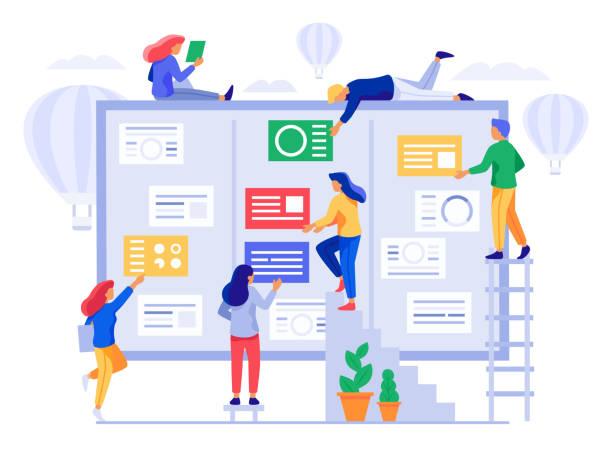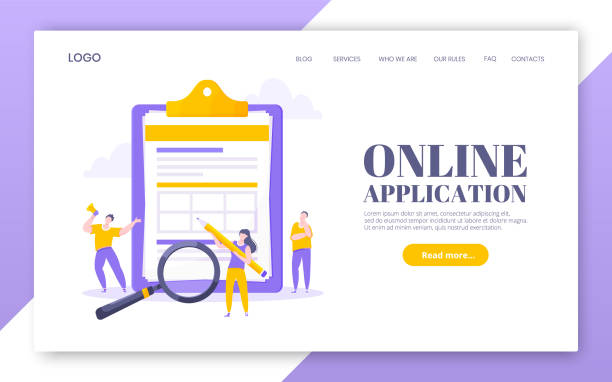Introduction to Corporate Website Design: Your Business’s Digital Gateway
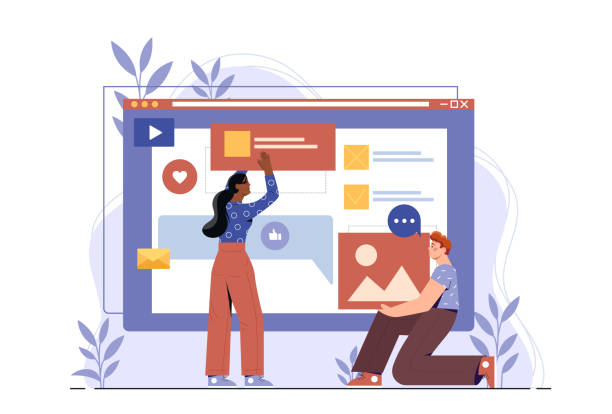
In today’s world, where digitalization has permeated all aspects of our lives, #corporate_website_design is no longer a luxury choice, but a #strategic_necessity for any business seeking to survive, grow, and achieve success in competitive markets.
A corporate website acts as an always-open #headquarters that attracts potential customers, partners, and even talent from around the world.
This online platform not only shapes your #brand_identity in the digital space but also allows you to showcase your products and services comprehensively and attractively, communicate directly with your audience, and ultimately, significantly contribute to increasing sales and strengthening your market position.
This approach is the foundation of every successful #digital_marketing_strategy companies pursue.
The main goal of corporate website design is to create a professional, user-friendly, and secure platform that effectively supports the company’s business objectives.
These objectives can be very diverse; from a comprehensive introduction of the company and its history, precise display of portfolios and projects, providing a complete catalog of products and services, to offering customer support systems and attracting skilled personnel.
An efficient corporate website must be able to provide users with the necessary information quickly and easily, while also creating a positive user experience (UX).
Details such as attractive and modern visual design, high loading speed, logical navigation structure, and appropriate accessibility for all users and devices are crucial factors in achieving this goal.
Your website is the first digital impression audiences will have of your business, so it must be impactful and professional.
In fact, investing in the design and development of a professional corporate website is a smart #long-term_investment that yields significant returns.
In the current era, where information is rapidly accessible to everyone and competition is at its peak, a strong website can differentiate your company from competitors and serve as a powerful tool for building #trust and customer #loyalty.
Beyond a static online catalog, a modern corporate website should become a #dynamic and #interactive tool that not only provides information but also paves the way for two-way communication, gathering customer feedback, and offering active and continuous support.
This approach will guarantee the success and sustainability of your online presence and help you always stay one step ahead of competitors and maintain a strong presence in the digital space.
Is your current e-commerce website design not generating the expected sales?
RasaWeb is an expert in professional e-commerce website design!
✅ An attractive and user-friendly website aimed at increasing sales
✅ High speed and security for an ideal shopping experience⚡ Get a free consultation for online store design with RasaWeb!
The Importance and Benefits of a Powerful Online Presence Beyond a Simple Website

In today’s highly #competitive markets, simply having a website is not enough; what matters is a powerful and impactful #online_presence that can create real added value for your business.
A professional #corporate_website acts as your business’s main storefront in the digital world, allowing you to reach your audience #without_time_or_location_restrictions.
This is particularly crucial for attracting new customers and expanding your target market.
Imagine your business being accessible 24/7, with your information and services easily available; this is what an efficient corporate website design brings you, connecting you with customers from all over the world.
This competitive advantage is undeniable and essential for growth.
One of the most significant benefits of having a standard corporate website is #credibility_for_your_brand.
In a world where many customers research and gather information online before any in-person interaction or purchase, lacking a website or having an outdated and weak one can severely damage your credibility and portray your company as unprofessional in the mind of the audience.
A professional and up-to-date website conveys your #seriousness and #expertise, assuring customers that they are dealing with a reputable and trustworthy company.
Furthermore, a corporate website can act as a powerful #marketing tool.
By properly utilizing #SEO (Search Engine Optimization) techniques, you can ensure that your website ranks well in Google search results and directs targeted, high-quality traffic to your business, which in turn means an increased chance of converting visitors into customers.
Increased sales while simultaneously reducing costs are also significant achievements of effective corporate website design.
A website can largely automate sales processes, automatically answer frequently asked customer questions, and even provide online customer support services, all of which lead to reduced need for human resources and increased overall company productivity.
Moreover, the ability to #collect_data and #analyze user behavior through website analytical tools helps you make more informed marketing decisions and optimize your strategies based on real customer needs and preferences.
This data analysis capability elevates the website beyond a simple brochure, transforming it into an analytical and guiding tool for your business’s sustainable growth and development, ultimately leading to increased profitability.
Key Features of a Successful Corporate Website: Structure and Content

A successful #corporate_website is more than just an online showcase; it must act as a #dynamic tool for #interacting with audiences and achieving the company’s business objectives.
Understanding the #key_features of an efficient website is crucial for any business looking for corporate website design.
One of the most important of these features is #responsive_design, which ensures that your website is displayed correctly and beautifully on various devices, including mobile phones, tablets, and desktops.
Given that a significant portion of web traffic today comes from mobile devices, neglecting this aspect can lead to losing a large segment of your audience and search rankings, causing irreparable damage to the business.
#User_Experience (UX) and #User_Interface (UI) are also fundamental principles that directly impact user satisfaction with a website.
A website should have easy navigation, organized content, and simple processes for accessing information so that users can quickly and without confusion find what they need.
High-quality and engaging content is the backbone of any website.
This content should not only provide accurate and complete information about your products and services but also be #up-to-date and answer potential user questions.
Using high-quality images and videos, infographics, and storytelling can enhance the appeal of the content, making it entertaining yet educational for the audience and keeping them on your site for longer.
Website loading speed is another crucial factor.
Today’s users expect websites to load quickly, and even a few seconds of delay can lead to losing visitors.
Optimizing images, reducing unnecessary code, and using a CDN (Content Delivery Network) can help improve speed.
Furthermore, #website_security is of paramount importance, especially if you collect sensitive information or conduct financial transactions.
Implementing SSL/TLS certificates, regular security updates, and website firewalls are essential for protecting user data and maintaining their trust.
Finally, successful corporate website design must inherently include #search_engine_optimization (SEO) capabilities from the outset to attract high organic traffic and be visible in search results.
Table 1: Checklist of Essential Corporate Website Features
| Feature | Description | Importance |
|---|---|---|
| Responsive Design | Compatibility with all devices (mobile, tablet, desktop) | Very High |
| High Loading Speed | Low time for loading website pages | Very High |
| Security (SSL) | Protection of user information and website data | Critical |
| Appropriate User Experience (UX) | Easy navigation and quick access to information | High |
| High-Quality and Up-to-Date Content | Comprehensive, accurate, and engaging information about services and products | Very High |
| SEO Friendly | Optimization for search engines to increase visibility | Critical |
| Clear Communication Channels | Contact form, phone number, email, and social media addresses | High |
Step-by-Step Corporate Website Design: From Idea to Implementation

#Corporate_website_design_phases are a #structured and multifaceted process that must be carefully and systematically followed to achieve a successful and efficient website.
Understanding these phases helps employers have realistic expectations, proceed with full awareness, and prevent potential problems.
The first, and perhaps most important, step is #detailed_analysis_and_planning.
In this stage, business needs, primary website objectives (such as increasing brand awareness, lead generation, or online sales), target audience and their behavior, and the strengths and weaknesses of your competitors are thoroughly examined and analyzed.
Determining required features, preparing an initial roadmap (Site Map), and developing a content strategy are of high importance.
This phase acts as an explanatory and guiding phase for the entire project, laying the foundation for future successes.
After the planning phase, it’s time for #User_Interface (UI) and #User_Experience (UX) design.
In this stage, designers use tools like wireframes and prototypes to define the visual structure, element layout, user flow, and navigation paths of the website.
The main goal is to create a smooth, pleasant, and intuitive user experience that guides the user towards the website’s business objectives and keeps them on the website for a longer period.
This section includes selecting colors, fonts, images, and graphic elements that must align with your brand’s visual identity and convey a sense of trust and professionalism.
At this stage, the importance of #attention_to_detail and #aesthetics doubles to create a visually appealing and user-friendly design.
Then, the #implementation or #coding phase begins.
In this stage, web designers and developers convert the approved graphic designs into executable code (HTML, CSS, JavaScript).
This includes the development of the front-end (what users see) and the back-end (which handles server logic, database, and content management).
Using frameworks and Content Management Systems (CMS) like WordPress, Joomla, or Drupal can help accelerate and improve the quality of this stage.
After implementation, the #testing_and_validation phase takes place to ensure the correct functioning, security, cross-browser compatibility, and performance of the website.
Finally, after bug fixes and final approval by the client, the website is uploaded to the server and officially #launched.
These precise steps are essential for any successful and sustainable corporate website design.
Did you know your company’s website is the first point of contact for 75% of potential customers?
Your website is the face of your brand. With **RasaWeb**’s corporate website design services, build an online presence that earns customer trust.
✅ Create a professional and lasting image for your brand
✅ Attract target customers and increase online credibility
⚡ Get a free consultation from **RasaWeb** experts!
Technologies and Tools Used in Corporate Web Design
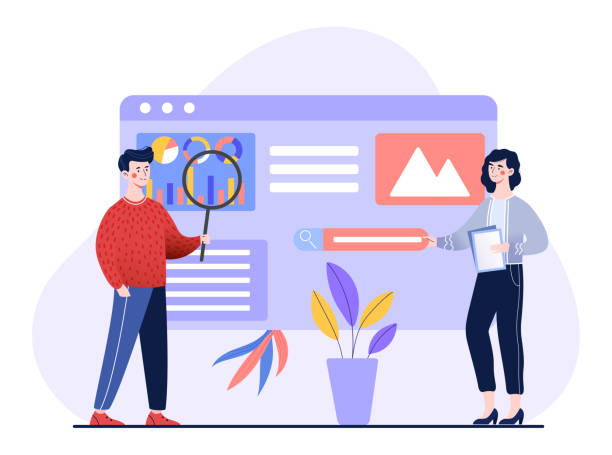
In the fast-paced world of #web_design, choosing the right #technologies and #tools for #corporate_website_design plays a vital role in project success.
These choices can directly impact development speed, the website’s final performance, information security, and its future scalability.
For the #front-end, which includes all visual and interactive elements a user sees in their browser, HTML is used as the primary language for structuring content, CSS for styling and visual design (color, font, layout), and JavaScript for adding dynamic interactions and advanced features.
Advanced JavaScript frameworks like React, Angular, or Vue.js are also very popular for building more complex user interfaces and Single Page Applications (SPAs) that offer a faster user experience.
In the #back-end section, responsible for server logic, databases, and APIs (Application Programming Interfaces), various programming languages are used.
Python (with frameworks like Django or Flask), PHP (with frameworks such as Laravel or Symfony), Ruby (with Ruby on Rails), and Node.js (with Express.js) are among the common options.
The choice of back-end language depends on the specific project needs, desired scalability, budget, and the development team’s expertise.
Databases are also indispensable components of any website; MySQL, PostgreSQL, MongoDB, and SQL Server are among the widely used options for storing and managing corporate website information, including customer data, products, and content.
Furthermore, #Content_Management_Systems (CMS) like WordPress, Joomla, or Drupal are powerful tools for building and managing corporate websites, especially for businesses that need to update content continuously and may have limited internal technical resources.
These CMSs, by offering diverse templates and plugins, accelerate the corporate website design and development process and provide easy content management capabilities.
The correct selection of these technologies is a specialized and analytical decision that must be made with great care, taking into account the long-term goals of the business.
Search Engine Optimization (SEO) in Corporate Website Design
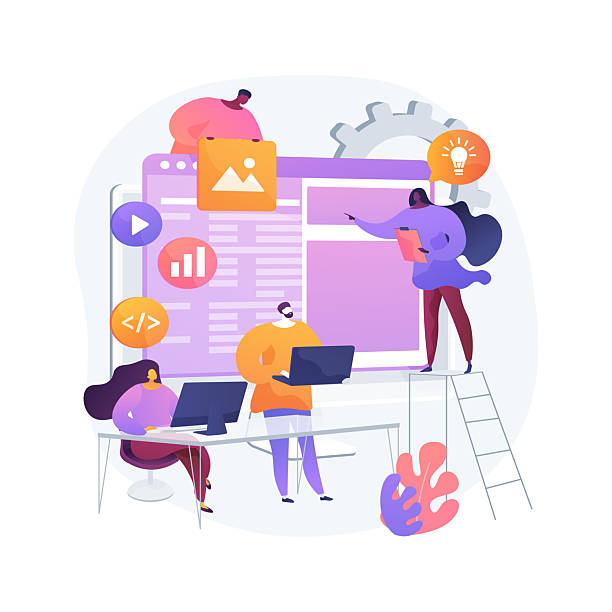
#SEO (Search Engine Optimization) is an integral part of every successful #corporate_website_design project.
Without a strong SEO strategy, even the most beautiful and user-friendly website might get lost among a multitude of other websites and not be found by the target audience.
The primary goal of SEO is to increase your website’s #visibility in organic search engine results such as Google, Bing, and Yahoo.
This means that when potential customers search for terms related to your business, your website should rank high in the results and attract organic and targeted traffic.
This is a long-term_strategy and crucial for sustainable online growth.
Various aspects are involved in SEO that must be considered from the very beginning of the corporate website design process.
#Technical_SEO includes optimizing website structure (such as information architecture and internal linking), page loading speed, mobile-friendliness, using SSL certificates for security (HTTPS), and clean, standard code structure.
#Content_SEO focuses on creating high-quality, relevant, and keyword-rich content.
This content must meet user needs, provide #comprehensive and #reliable information, and answer their questions.
Proper use of relevant keywords in headings (H1, H2, H3), meta descriptions, and the main text of pages helps search engines better understand your website’s topic and authority.
#Off-Page_SEO also refers to activities such as backlink building from other reputable and relevant websites, which adds to your website’s credibility and domain authority in the eyes of search engines.
Furthermore, using tools like Google Search Console and Google Analytics is crucial for monitoring website performance, identifying effective keywords, analyzing user behavior, and discovering opportunities for SEO improvement.
These tools provide valuable information about how users interact with your website, which is highly important for precise analysis and expert guidance to improve rankings and increase traffic.
Corporate website design without considering SEO is like building a beautiful store in the desert that no one can find.
Maintenance, Updates, and Development of Corporate Websites: Longevity in the Digital World
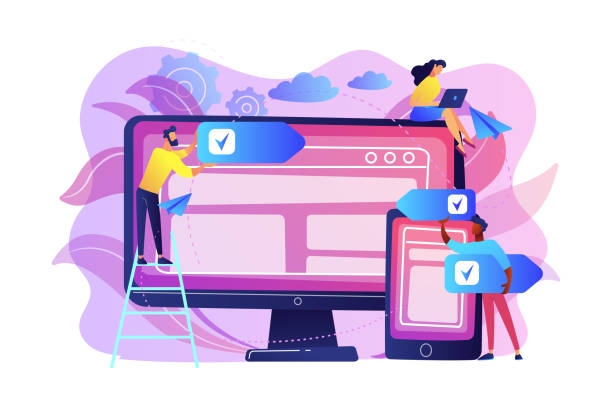
After the completion of the #corporate_website_design process and its successful launch, the work doesn’t end; it only begins.
#Continuous_maintenance_and_updates of the website are crucial to ensure smooth operation, high security, and its relevance to current market needs and user expectations.
A forgotten website quickly becomes obsolete, its security is compromised, and ultimately, it will have a negative and irreparable impact on your business’s reputation.
Maintenance includes regular security checks, full data backups, updating plugins, themes, and the CMS core (if using content management systems), and continuous monitoring of website performance to identify and fix potential errors.
These measures are educational and guiding for maintaining your digital health and dynamism.
Cyber_security is one of the most important reasons for continuous updates.
Given the increasing security threats such as cyber attacks, malware, and intrusion attempts, software updates often include security patches that address vulnerabilities.
Ignoring these updates can expose your website to serious risks, leading to data loss, reputation damage, or even legal penalties.
In addition to security, #content_updates are also of particular importance.
Fresh, relevant, and high-quality content not only helps improve SEO rankings but also encourages users to return to your website and engage with your brand.
This can include adding new blog posts, updating product or service information, and answering Frequently Asked Questions (FAQ) so that the website always has fresh news for its audience.
#Website_development also means adding new features, improving performance, and enhancing its scalability over time.
As your business grows, you may need to add new sections such as a comprehensive online store, customer portal, online booking system, or more advanced features for user interaction.
This development must be carried out with careful planning and consideration of #website_architecture to prevent future problems and ensure the website can respond to your changing business needs.
Monitoring website performance through tools like Google Analytics and Google Search Console to identify weaknesses and opportunities for improvement is a critical component of strategic maintenance and development.
These activities ensure that your corporate website remains dynamic, secure, and efficient.
Table 2: Key Corporate Website Maintenance Tasks
| Task | Description | Frequency |
|---|---|---|
| Data Backup | Regular storage of all website information and files in secure locations | Weekly/Monthly |
| Software and Plugin Updates | Updating CMS core, themes, and plugins for security and performance | Monthly/Quarterly |
| Security Scan and Malware Removal | Scanning the website to identify and eliminate security threats and malicious code | Monthly/Quarterly |
| Performance Monitoring | Checking loading speed, broken links, server errors, and response time | Weekly |
| Content Updates | Adding new content (articles, news), updating existing and old information | Ongoing |
| Technical Support | Addressing technical issues, bugs, and questions from users and internal team | As Needed |
Costs and Factors Affecting Corporate Website Design Budget: Value vs. Price
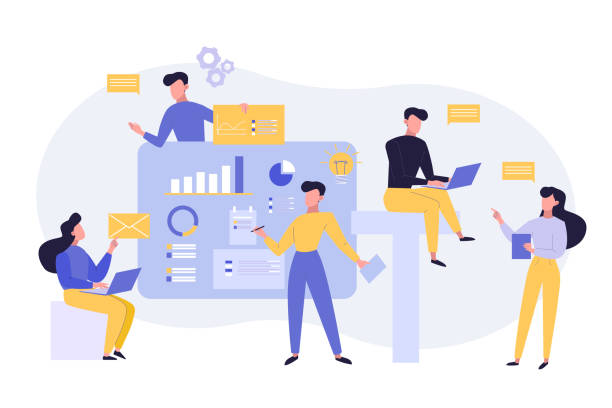
The #cost_of_corporate_website_design is one of the first and most important questions any business faces at the beginning of its #online_presence journey.
The answer to this question depends on numerous factors, and a fixed, specific figure cannot be provided, as each corporate website design project is unique and has its own specific needs.
In fact, the #website_design_budget is a function of project complexity, required features, the experience and reputation of the design team or company, and the type of platform or technology used.
Do you need a simple website to introduce your company and main services, or a complex platform with online sales (e-commerce store), customer portal, advanced content management system, and integration with other business systems? The answer to this question will significantly impact the final budget and confront you with the nature of the questionable content of costs.
Among the main factors directly affecting costs, we can refer to #customized_design versus using ready-made templates.
A completely custom design, built from scratch based on your business’s unique needs, usually costs more but provides better flexibility, visual distinctiveness, and performance.
In contrast, using ready-made templates can be more cost-effective and reduce development time, but it may have limitations in design, customizability, and future scalability.
Also, the #number_of_pages on the website, the need for #special_features such as complex forms, online booking systems, online chat, multilingual capabilities, or integration with other systems (like CRM, ERP, accounting systems) directly impacts the final cost.
Each additional feature requires more time and expertise.
In addition to the initial #website_design costs, the #ongoing and sustainability costs must also be considered.
These include #hosting costs (server space and bandwidth rental), #domain_registration_and_renewal (website address), #SSL_certificate for secure communications, and technical and content #maintenance_and_un_support services.
These costs are essential for maintaining the correct functioning, security, and up-to-dateness of the website in the long term and should not be overlooked.
Choosing an experienced and specialized web design team, although it may seem more expensive initially, can save costs in the long run and increase your return on investment by preventing costly mistakes, providing a high-quality website optimized for SEO, and scalable.
Therefore, you should always look for value for money, not just the cheapest option.
This is an important economic analysis.
Did you know that 94% of users’ first impressions of a business are related to its website design? With professional corporate website design by **RasaWeb**, turn this first impression into an opportunity for growth.
✅ Attract more customers and increase sales
✅ Build credibility and trust in the audience’s eyes⚡ Get a free website design consultation!
Common Mistakes in Corporate Website Design and How to Avoid Them
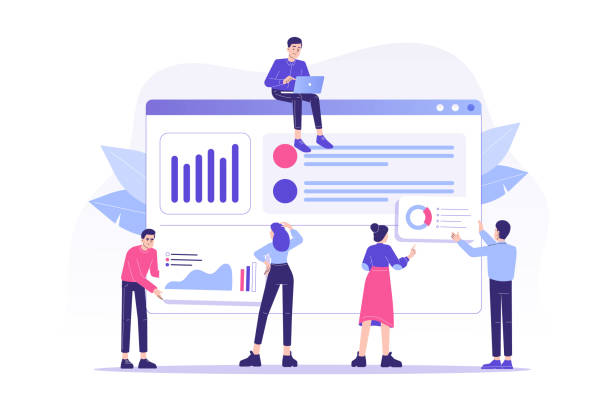
On the path of #corporate_website_design, businesses may encounter common mistakes that can seriously harm their efforts and investments.
Recognizing these #common_mistakes and knowing how to avoid them is key to building a successful and efficient website that truly serves your business objectives.
One of the biggest mistakes, #ignoring_the_target_audience, is a crucial educational lesson in this regard.
A website designed without meeting the needs, preferences, and expectations of users, even with the most beautiful appearance and modern technology, will not be successful.
Your website should be built for your audience, not just for your personal taste or the company’s managers.
Thorough audience research and creating user personas is a crucial educational lesson in this regard.
#Lack_of_mobile_optimization (Non-Responsive Design) is another common error that, given the significant increase in smartphone and tablet usage for internet access, can lead to losing a vast portion of traffic and potential customers.
Your website must display well and function efficiently on any device with any screen size.
Furthermore, #slow_page_loading_speed is a factor that severely harms user experience and can cause visitors to leave the website before seeing your content.
Optimizing image sizes, compressing code, using caching, and choosing a powerful and suitable hosting provider are key ways to improve speed and are essential for accurate #performance_analysis.
Ignoring #SEO from the start is also a costly mistake.
SEO should not be added after the completion of corporate website design; instead, it should be considered a fundamental element from the initial planning and development stages.
Website structure, the use of relevant keywords, and the production of high-quality, SEO-optimized content should all be carried out with an SEO-centric approach.
#Inappropriate or #irrelevant_content can also confuse users and diminish your credibility.
Content should be clear, concise, engaging, and useful, providing added value for the user.
Finally, #failure_to_include_clear_contact_methods and calls-to-action can lead to visitors not knowing what to do after visiting the website or how to contact you.
These mistakes must be carefully analyzed, and necessary guidance to avoid them should be followed to achieve a powerful and impactful corporate website.
The Future of Corporate Website Design and Upcoming Trends: Innovation Serving Business

The #future_of_corporate_website_design is constantly evolving, and with the emergence of #new_technologies and changing #user_behavior, new trends are appearing in this field, the understanding of which is essential for any business seeking to maintain competitiveness and achieve the maximum potential of its website.
One of the most important future trends is #personalization_of_user_experience.
Websites will increasingly use data, Artificial_Intelligence (AI), and #machine_learning to deliver content, products, and services tailored to each user’s unique needs and interests.
This approach transforms the website into an entertaining yet highly functional tool that evokes a more personal connection with the user.
#Conversational_user_interfaces and #voice_search are also on the rise.
With the widespread use of voice assistants like Siri, Google Assistant, and Alexa, websites need to be optimized to respond to voice queries and provide natural conversational experiences.
This necessitates changes in how content is structured and keywords are optimized for voice search so that your site doesn’t fall behind in the era of new news technology.
Furthermore, Artificial_Intelligence and Machine_Learning will play a more prominent role in improving SEO (by analyzing search patterns), analyzing user behavior, and automating processes (such as customer support via chatbots).
From smart #chatbots for answering frequently asked questions to content and product recommendation systems, AI can significantly enhance user experience and increase business efficiency.
Corporate website design and development in the future will focus more on #immersive and #interactive_experiences.
The use of Augmented Reality (AR) and Virtual Reality (VR) for displaying products in 3D, conducting virtual tours of the company or showroom, and creating richer and more immersive experiences for users is gradually becoming a reality, pushing the boundaries of online interaction.
#Focus_on_sustainability and #social_responsibility are also important trends; websites will move towards being not only visually appealing and high-performing but also technically optimized and energy-efficient (e.g., optimizing to reduce server energy consumption).
These developments indicate that corporate website design and construction is not a static field but requires continuous analysis and updating with the latest technologies and user expectations to always bring news of innovation to your business and keep you at the peak of competitiveness.
Frequently Asked Questions
| Question | Answer |
|---|---|
| What is a corporate website? | It is a website that companies use to introduce themselves, their products or services, history, and contact information with the aim of attracting customers and increasing credibility. |
| Why is corporate website design important? | For creating a digital identity, increasing customer access, online marketing and sales, showcasing portfolios, and building brand trust and credibility. |
| What main sections should a corporate website have? | Company introduction (About Us), products/services, Contact Us, news or blog, portfolio, and an attractive homepage. |
| Is corporate website design essential for small businesses? | Yes, even small businesses can appear more professional, reach more customers, and better introduce their services by having a corporate website. |
| What are the most important features of a good corporate website? | Professional and user-friendly appearance, mobile compatibility (responsiveness), high loading speed, engaging and up-to-date content, and clear contact information. |
And other services by RasaWeb Advertising Agency in the field of advertising
Smart Brand Identity: A fast and efficient solution to increase sales with a focus on Google Ads management.
Smart Custom Software: Designed for businesses seeking to increase click-through rates through an SEO-driven content strategy.
Smart Advertorials: A fast and efficient solution to increase website traffic with a focus on custom programming.
Smart Sales Automation: A combination of creativity and technology to improve SEO ranking through an SEO-driven content strategy.
Smart Content Strategy: An innovative service to enhance campaign management through key page optimization.
And over a hundred other services in internet advertising, advertising consultation, and organizational solutions
Internet Advertising | Advertising Strategy | Advertorials
Resources
Professional Corporate Website Design
Complete Guide to Smart Website Design
Tips for Successful Website Design
WordPress Website Design for Companies
❓ Are you ready to transform your business in the digital world? RasaWeb Digital Marketing Agency, specializing in professional e-commerce website design, SEO, and online brand enhancement, paves your way to success.
📍 Tehran, Mirdamad Street, next to Bank Markazi, Kazeroon Jonoubi Alley, Ramin Alley, No. 6

